A briefing from the CongoPeat international team of scientists

Simon L. Lewisa,b, Corneille Ewangoc , Bart Crezeea, Ifo Suspense Avertid & the CongoPeat consortiume
Download the briefing as a PDF.
GLOBAL IMPORTANCE OF THE PEATLANDS
- In 2017 we revealed that the world’s largest tropical peatland is in the central Congo Basin1.
- Our latest map published this year shows that peat covers 16.8 million hectares, 11.3 million hectares in Democratic Republic of the Congo (DRC), and 5.5 million hectares in Republic of the Congo (RoC)2. The total area is 15% greater than our 2017 map.
- The carbon stored in the peat is the same as the carbon stored in all the trees across the whole of the Republic of the Congo and Democratic Republic of the Congo combined, despite the peat only covering 6% of the two countries.
- The swamp forests that overlie the peat are some of the world’s richest for wildlife. Major populations of forest elephants, lowland gorillas, bonobos, chimpanzees, Allen’s swamp monkey and African dwarf crocodile live there.
- Today the peatlands are largely intact, and are used sustainably by local people. However, the carbon stored in the peat is directly under threat from oil exploration and exploitation, logging concessions, and industrial agriculture.
- New analyses published in Nature show that climate change is a further risk. Future droughts may tip the ecosystem from a major carbon store to a large carbon source, accelerating climate change.
- If the central Congo Basin peatlands became a large source of carbon to the atmosphere, whether by drainage or the impacts of climate change, this would threaten international commitments to limit global heating to 1.5°C.
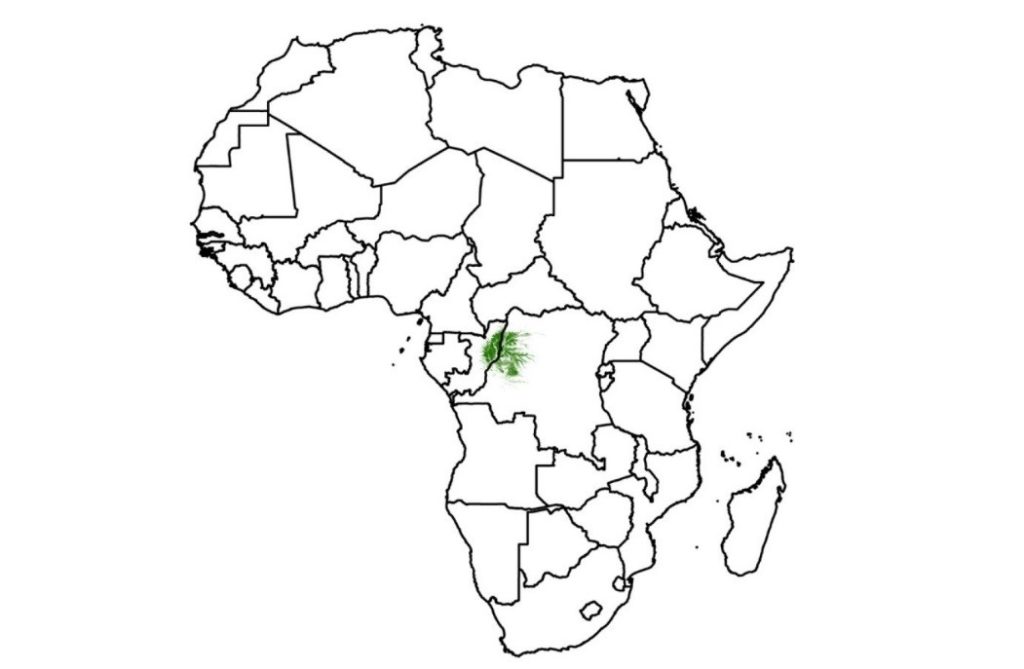
IMPACTS OF CLIMATE CHANGE
- New analyses published in Nature show the vulnerability of the central Congo peatlands to drought3.
- Sampled peat cores from the region show that there was a period of around 5,000 years when there was almost no build-up of peat, less than 0.1 mm per year (see Figure below).
- Analyses of the preserved plant remains in the peat – leaf waxes and pollen grains – show that the peatlands experienced a drying climate, starting 5,000 years ago, that got progressively drier until about 2,000 years ago, with swamp forest specialist plant species declining.
- The drought lowered the water table, resulting in peat decomposition, with 2 to 4 metres of peat lost from what is today a 6 metre thick column of peat. This resulted in a ‘ghost interval’ of very little peat build up, compared to the time before or after (see Figure below).
- The peatland changed from a carbon sink to a carbon source as the peat decomposed. This decomposition only stopped when the drought stopped about 2,000 years ago, when peat started accumulating again.
- The study is a warning from the past: if the peatlands dry beyond a certain threshold they will release carbon to the atmosphere, which would accelerate future climate change.
- In the modern-day climate, there is some evidence that dry seasons are lengthening in the Congo Basin. The latest climate models, while uncertain, suggest an increasing likelihood of extreme drought conditions in this region4. This highlights the need to avoid other causes of peatland drying such as drainage.
- Our study provides evidence that drier conditions have existed in the past and pushed the peatlands past a tipping point causing them to become a source of carbon to the atmosphere. This could happen again in the future if droughts increase.
- The central Congo peatlands store 29 billion tonnes of carbon. The release of this carbon, even slowly, will make the Paris Agreement harder to achieve.
- The sooner anthropogenic carbon emissions decline to net zero, the lower the likelihood of the Congo peatlands drought tipping point being breached.
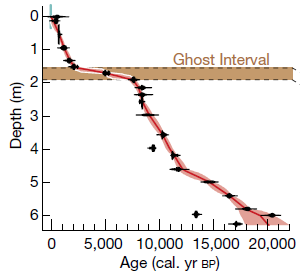
DIRECT IMPACTS ON THE PEATLANDS: OIL EXPLORATION AND LOGGING
- While the peatlands are largely intact today, and sustainably managed by local people, overlaying our peat map on areas permitted for logging and industrial agriculture shows that oil palm (red shading) threatens RoC peatlands, and logging concessions (red outlines) threaten DRC peatlands.
- Overlaying our peat map onto the oil blocks proposed for auction in DRC shows 1 million hectares of peatland within three oil blocks. Oil exploration opens new access routes into forests and peatlands, typically leading to ecosystem degradation and deforestation through hunting, logging, and agriculture expansion, whether oil is found or not5.
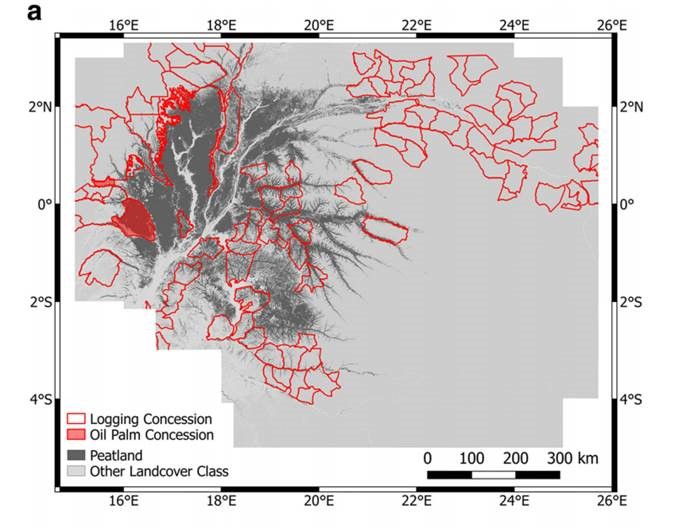
- There are 1.6 billion tonnes of carbon in peat inside the three oil blocks. Should the peat carbon be released to the atmosphere, the peatland oil would be among the most carbon-intensive oil ever produced6.
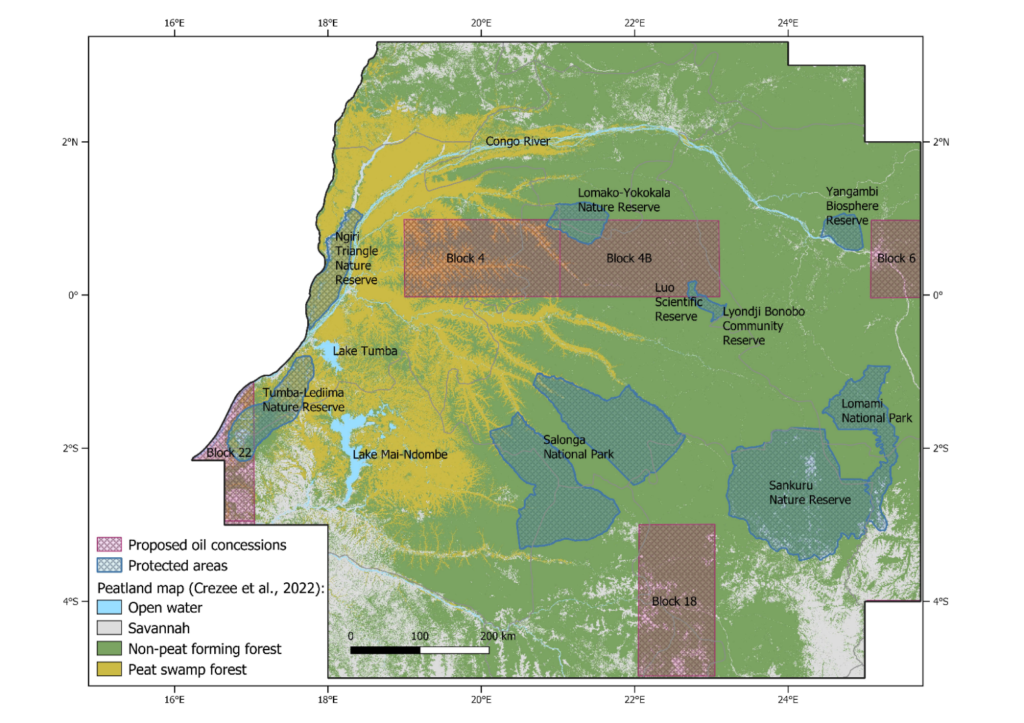
THE PEATLANDS ARE HIGHLY SENSITIVE TO ENVIRONMENTAL CHANGE
- Our research has shown that between 5,000 and 2,000 years ago substantial amounts of peat decomposed, as the climate dried beyond a threshold. It is likely that other types of change will impact the peatlands.
- The photos opposite show the building of a road for access to a logging camp, which altered the drainage of the peat swamp, and killed all the trees, well within two decades.
- More severe than this would be deliberate drainage for agriculture. This occurred extensively in Southeast Asian tropical peatlands, leading to out-of-control fires in drought years, coupled with the decomposition of peat, and enough carbon being emitted that it could be detected in levels of carbon dioxide in the atmosphere. This should be avoided in the central Congo.
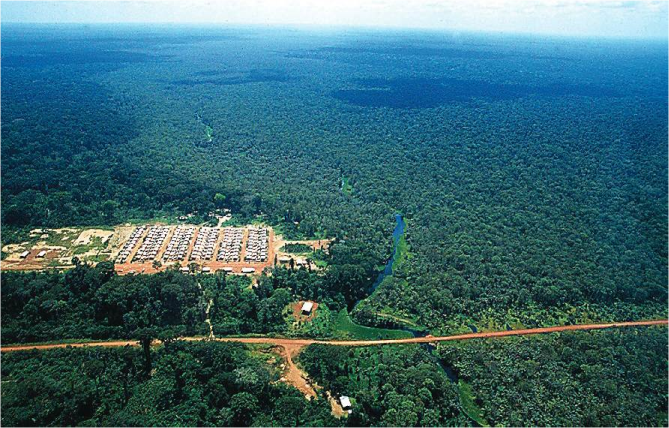

NEXT STEPS
- CongoPeat funding ends in 2023, so resources are needed for data collection, analysis and modelling to understand future of the peatlands, whether from climate change or the impacts of oil development, logging, or industrial agriculture, to avoid irreversible changes to the peatland system. Expanding the search for peatlands across the Congo Basin is also needed.
- Beyond science, new programmes are needed to assist countries and communities to pursue development pathways that improve lives and protect the peatlands and their biodiversity.
For more information, Professor Simon Lewis will be speaking on Tue 8 Nov 16.45-18.15 EET (14.45-16.15 GMT) at the side event Congo Basin: Raising Ambitions and Driving Solutions in the UK Pavilion.
Join the livestream via the UK Government YouTube channel: https://www.youtube.com/watch?v=6GeLDMSCDwU
1Dargie et al. 2017. Age, extent and carbon storage of the central Congo Basin peatland complex. Nature. 2Crezee et al. 2022. Mapping peat thickness and carbon stocks of the central Congo Basin. Nature Geoscience. 3Garcin et al. 2022. Hydroclimatic vulnerability of peat carbon in the central Congo Basin. Nature. 4 Caretta et al. 2021. Chapter 4, Water. IPCC Working Group II, Sixth Assessment Report. 5Lawson et al. 2022. The vulnerability of tropical peatlands to oil and gas exploration and extraction. Progress in Environmental Geography. 6For further details see our CongoPeat briefing on oil exploration, https://congopeat.net/briefings/
aUniversity of Leeds bUniversity College London cUniversity of Kisangani, DRC, dMarien Ngouabi University, Republic of the Congo, eAndrew Baird, Richard Betts, George Biddulph, Yannick Bocko, Arnoud Boom, Peter Cook, Greta Dargie, Ovide Emba, Selena Georgiou, Nick Girkin, Charles Hackforth, Donna Hawthorne, Shona Jenkins, Jonay Jovani Sancho, Joseph Kanyama, Ian Lawson, Emmanuel Mampouya, Mackline Mbemba, Lera Miles, Edward Mitchard, Paul Morris, Susan Page, Sofie Sjögersten, Dylan Young.
